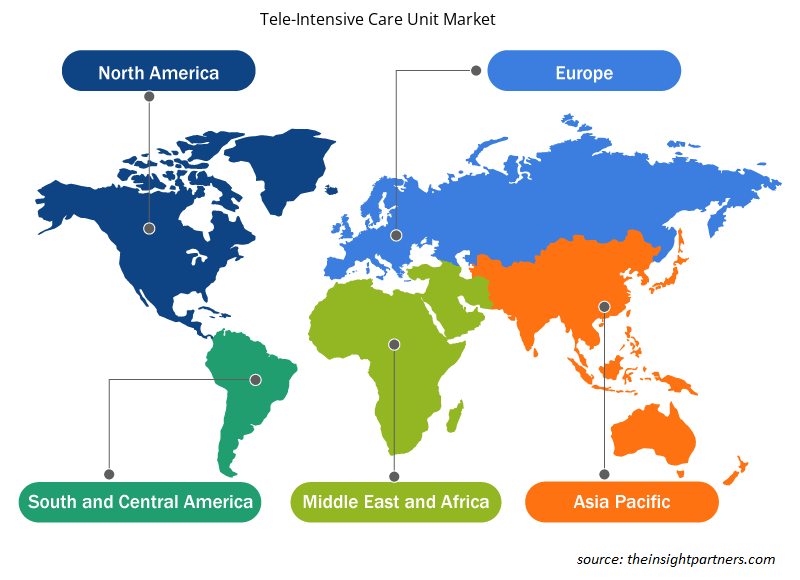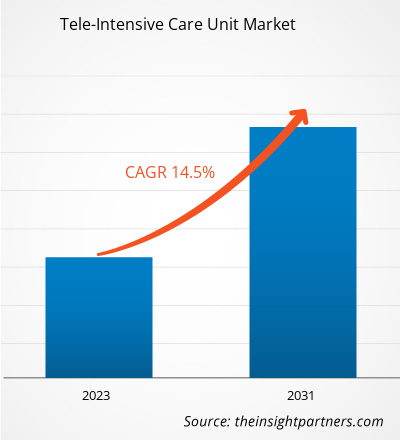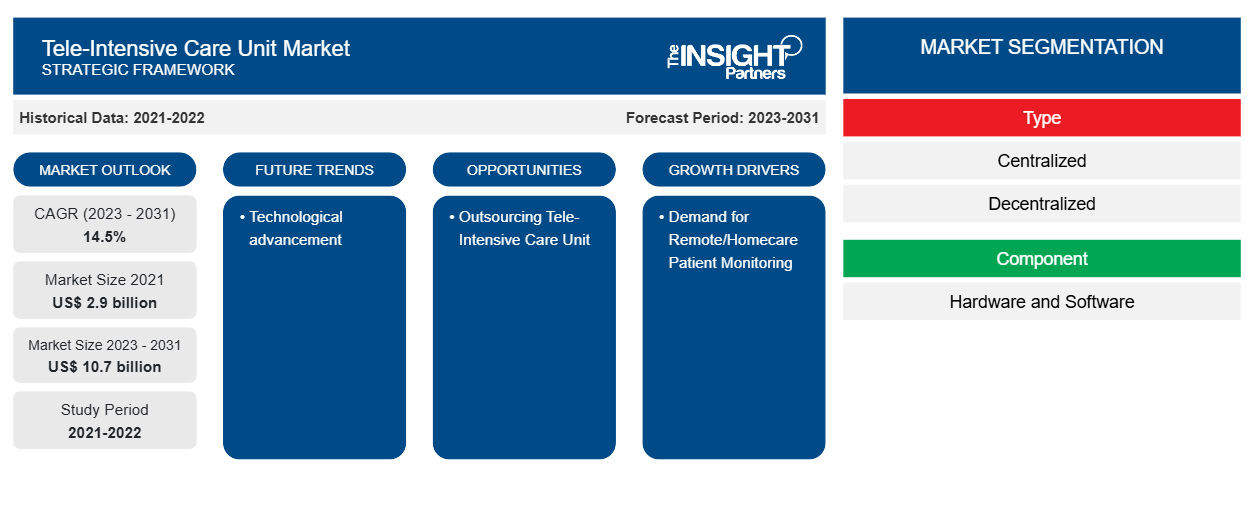Il mercato delle unità di terapia intensiva telemedica è stato valutato a 2,9 miliardi di dollari nel 2021 e si prevede che raggiungerà i 10,7 miliardi di dollari entro il 2031. Si prevede che il mercato registrerà un CAGR del 14,5% dal 2023 al 2031.
È probabile che la crescente integrazione tra tecnologia e assistenza sanitaria nelle strutture sanitarie rimanga una tendenza chiave nel mercato delle unità di terapia intensiva a distanza.
Analisi di mercato delle unità di terapia intensiva telematica
Domanda di monitoraggio remoto/domiciliare dei pazienti
L'integrazione della tele-ICU migliora la capacità complessiva e la produttività per gli ospedali con bassi ricoveri, riammissioni e somministrazione di cure a distanza. Inoltre, la capacità della tele-ICU di ridurre la durata della degenza (LOS) consente agli ospedali di migliorare la capacità e la produttività ricoverando più pazienti mantenendo lo stesso numero di posti letto di terapia intensiva e i costi associati del personale della ICU. Gli ospedali stanno affrontando una pressione enorme per ottenere risultati sanitari migliori a causa di gravi carenze di medici e infermieri. Per affrontare questo problema, vari studi/indagini rivelano che la tele-ICU può aiutare i sistemi sanitari a migliorare le operazioni, consentendo a più pazienti di essere curati in ICU di ospedali comunitari a bassa capacità anziché trasferirli in ospedali/centri terziari ad alta capacità e costo elevato. Ad esempio, l'installazione della tele-ICU in ospedali comunitari con bassi tassi di occupazione rispetto ai grandi centri medici accademici (AMC) trae vantaggio dal mantenimento di più pazienti presso le loro strutture ICU comunitarie, aumentando la Revenue Cycle Management (RCM) e migliorando la sostenibilità dell'erogazione dell'assistenza sanitaria. I fattori sopra menzionati sono responsabili della crescita influente del mercato delle unità di terapia intensiva a distanza.
Panoramica del mercato delle unità di terapia intensiva telematica
Tecnologia, innovazione e soluzioni tecnologiche intelligenti continuano a influenzare in modo significativo l'unità di terapia intensiva a distanza. La domanda di monitoraggio remoto/ domiciliare dei pazienti e risultati ospedalieri efficienti tramite l'unità di terapia intensiva a distanza sono i fattori più influenti responsabili della crescita del mercato dell'unità di terapia intensiva a distanza. Il progresso tecnologico è una tendenza chiave per la crescita del mercato dell'unità di terapia intensiva a distanza. L'outsourcing dell'unità di terapia intensiva a distanza fornirà un'opportunità di mercato redditizia.
Personalizza questo report in base alle tue esigenze
Riceverai la personalizzazione gratuita di qualsiasi report, comprese parti di questo report, o analisi a livello nazionale, pacchetto dati Excel, oltre a usufruire di grandi offerte e sconti per start-up e università
-
Scopri le principali tendenze di mercato in questo rapporto.Questo campione GRATUITO includerà analisi di dati che spaziano dalle tendenze di mercato alle stime e alle previsioni.
Driver e opportunità del mercato delle unità di terapia intensiva telematica
Risultati ospedalieri efficienti attraverso l'unità di terapia intensiva telematica per favorire il mercato
Secondo le statistiche pubblicate dal rapporto Koninklijke Philips NV, uno studio quinquennale condotto negli ospedali rivela che l'impatto della tele-ICU su 188.990 pazienti in terapia intensiva in 56 ICU, 32 ospedali e 19 sistemi sanitari ridotti ha portato a una diminuzione dei casi di mortalità dei pazienti e della durata della degenza (LOS). Inoltre, un altro studio pubblicato dal rapporto Koninklijke Philips rivela che la tele-ICU riduce le richieste di risarcimento per negligenza sanitaria di quasi il 90%.
Pertanto, risultati ospedalieri efficienti in termini di riduzione delle denunce per negligenza medica, basso tasso di mortalità e rapide dimissioni dei pazienti ospedalieri contribuiranno in modo significativo allo sviluppo del mercato delle terapie intensive a distanza nei prossimi anni.
Esternalizzazione dell’unità di terapia intensiva a distanza: un’opportunità
Per le unità sanitarie o gli ospedali a bassa capacità (capacità inferiore a 50 posti letto in terapia intensiva), potrebbe non essere possibile implementare una tele-ICU aziendale completa con una struttura interna. Pertanto, le unità sanitarie o gli ospedali su piccola scala potrebbero collaborare con i principali fornitori di servizi di tele-ICU. Ad esempio, l'approccio modulare Philips al servizio di tele-ICU aziendale consente alle unità sanitarie o agli ospedali a bassa capacità di aumentare/acquistare grandi posti letto in terapia intensiva utilizzando un piano di implementazione efficiente. Ad esempio, il "programma di outreach eICU" Philips facilita l'accesso a un'ampia gamma di unità di terapia intensiva o ospedali di piccole e grandi dimensioni tramite una partnership con un investimento minimo. Pertanto, l'adozione dell'outsourcing del servizio di tele-ICU da parte di unità di terapia intensiva o ospedali di piccola capacità fornirà opportunità di mercato redditizie che rappresenteranno una quota di mercato considerevole nei prossimi anni per il mercato delle unità di terapia intensiva teleintensiva.
Analisi della segmentazione del rapporto di mercato delle unità di terapia intensiva telemedica
I segmenti chiave che hanno contribuito alla derivazione dell'analisi di mercato delle unità di terapia intensiva telematica sono le candidature e i servizi.
- In base al tipo, il mercato è diviso in centralizzato, decentralizzato e altri. Il segmento centralizzato potrebbe detenere una quota di mercato maggiore nel 2023.
- Per componente, il mercato è segmentato in hardware e software. Il segmento hardware potrebbe detenere la quota maggiore del mercato nel 2023.
Analisi della quota di mercato delle unità di terapia intensiva telematica per area geografica
L'ambito geografico del rapporto sul mercato delle unità di terapia intensiva telematica è suddiviso principalmente in cinque regioni: Nord America, Asia Pacifico, Europa, Medio Oriente e Africa e Sud America/Sud e Centro America.
Il Nord America ha dominato il mercato delle unità di terapia intensiva televisive. In Nord America, gli Stati Uniti rappresentano una quota considerevole per le unità di terapia intensiva televisive. La presenza di aziende leader di dispositivi medici presenti negli Stati Uniti, innovazioni di prodotto e prodotti tecnologicamente avanzati sono i fattori più influenti responsabili della crescita del mercato. Si prevede che l'Asia Pacifica crescerà con il CAGR più elevato nei prossimi anni.
Approfondimenti regionali sul mercato delle unità di terapia intensiva telematica
Le tendenze regionali e i fattori che influenzano il mercato delle unità di terapia intensiva telematica durante il periodo di previsione sono stati ampiamente spiegati dagli analisti di Insight Partners. Questa sezione discute anche i segmenti e la geografia del mercato delle unità di terapia intensiva telematica in Nord America, Europa, Asia Pacifico, Medio Oriente e Africa, e America centrale e meridionale.

- Ottieni i dati specifici regionali per il mercato delle unità di terapia intensiva telematica
Ambito del rapporto di mercato sulle unità di terapia intensiva tele-intensiva
| Attributo del report | Dettagli |
|---|---|
| Dimensioni del mercato nel 2021 | 2,9 miliardi di dollari USA |
| Dimensioni del mercato entro il 2031 | 10,7 miliardi di dollari USA |
| CAGR globale (2023-2031) | 14,5% |
| Dati storici | 2021-2022 |
| Periodo di previsione | 2023-2031 |
| Segmenti coperti |
Per tipo
|
| Regioni e Paesi coperti |
America del Nord
|
| Leader di mercato e profili aziendali chiave |
|
Densità dei player del mercato delle unità di terapia intensiva a distanza: comprendere il suo impatto sulle dinamiche aziendali
Il mercato delle unità di terapia intensiva telemedica sta crescendo rapidamente, spinto dalla crescente domanda degli utenti finali dovuta a fattori quali l'evoluzione delle preferenze dei consumatori, i progressi tecnologici e una maggiore consapevolezza dei benefici del prodotto. Con l'aumento della domanda, le aziende stanno ampliando le loro offerte, innovando per soddisfare le esigenze dei consumatori e capitalizzando sulle tendenze emergenti, il che alimenta ulteriormente la crescita del mercato.
La densità degli operatori di mercato si riferisce alla distribuzione di aziende o società che operano in un particolare mercato o settore. Indica quanti concorrenti (operatori di mercato) sono presenti in un dato spazio di mercato in relazione alle sue dimensioni o al valore di mercato totale.
Le principali aziende che operano nel mercato delle unità di terapia intensiva telematica sono:
- InTouch Technologies, Inc.
- Cure avanzate in terapia intensiva
- Koninklijke Philips NV
- Ceiba-TeleICU
- Bandiera Salute
- Assistenza TeleICU
Disclaimer : le aziende elencate sopra non sono classificate secondo un ordine particolare.

- Ottieni una panoramica dei principali attori del mercato delle unità di terapia intensiva telematica
Notizie di mercato e sviluppi recenti sulle unità di terapia intensiva telematica
Il mercato delle Tele-Intensive Care Unit viene valutato raccogliendo dati qualitativi e quantitativi post-ricerca primaria e secondaria, che includono importanti pubblicazioni aziendali, dati associativi e database. Di seguito è riportato un elenco degli sviluppi nel mercato delle Tele-Intensive Care Unit e delle strategie:
- A luglio 2023, Medanta (Group of Hospitals) ha annunciato il lancio dei servizi Tele-ICU in India come "progetto Medanta e-ICU" in collaborazione con GE Healthcare. La piattaforma eICU fornirà un monitoraggio dei pazienti quasi in tempo reale, anche in orari strani come mezzanotte, consentendo un intervento precoce sui pazienti.
Copertura e risultati del rapporto di mercato sulle unità di terapia intensiva telematica
Il rapporto "Dimensioni e previsioni del mercato delle unità di terapia intensiva tele-(2021-2031)" fornisce un'analisi dettagliata del mercato che copre le seguenti aree:
- Dimensioni e previsioni del mercato a livello globale, regionale e nazionale per tutti i segmenti di mercato chiave coperti dall'ambito
- Dinamiche di mercato come fattori trainanti, vincoli e opportunità chiave
- Principali tendenze future
- Analisi dettagliata delle cinque forze PEST/Porter e SWOT
- Analisi di mercato globale e regionale che copre le principali tendenze di mercato, i principali attori, le normative e gli sviluppi recenti del mercato
- Analisi del panorama industriale e della concorrenza che copre la concentrazione del mercato, l'analisi della mappa di calore, i principali attori e gli sviluppi recenti
- Profili aziendali dettagliati
- Analisi storica (2 anni), anno base, previsione (7 anni) con CAGR
- Analisi PEST e SWOT
- Valore/volume delle dimensioni del mercato - Globale, Regionale, Nazionale
- Industria e panorama competitivo
- Set di dati Excel
Report recenti
Testimonianze
Motivo dell'acquisto
- Processo decisionale informato
- Comprensione delle dinamiche di mercato
- Analisi competitiva
- Analisi dei clienti
- Previsioni di mercato
- Mitigazione del rischio
- Pianificazione strategica
- Giustificazione degli investimenti
- Identificazione dei mercati emergenti
- Miglioramento delle strategie di marketing
- Aumento dell'efficienza operativa
- Allineamento alle tendenze normative























 Ottieni un campione gratuito per - Mercato delle unità di terapia intensiva telematica
Ottieni un campione gratuito per - Mercato delle unità di terapia intensiva telematica